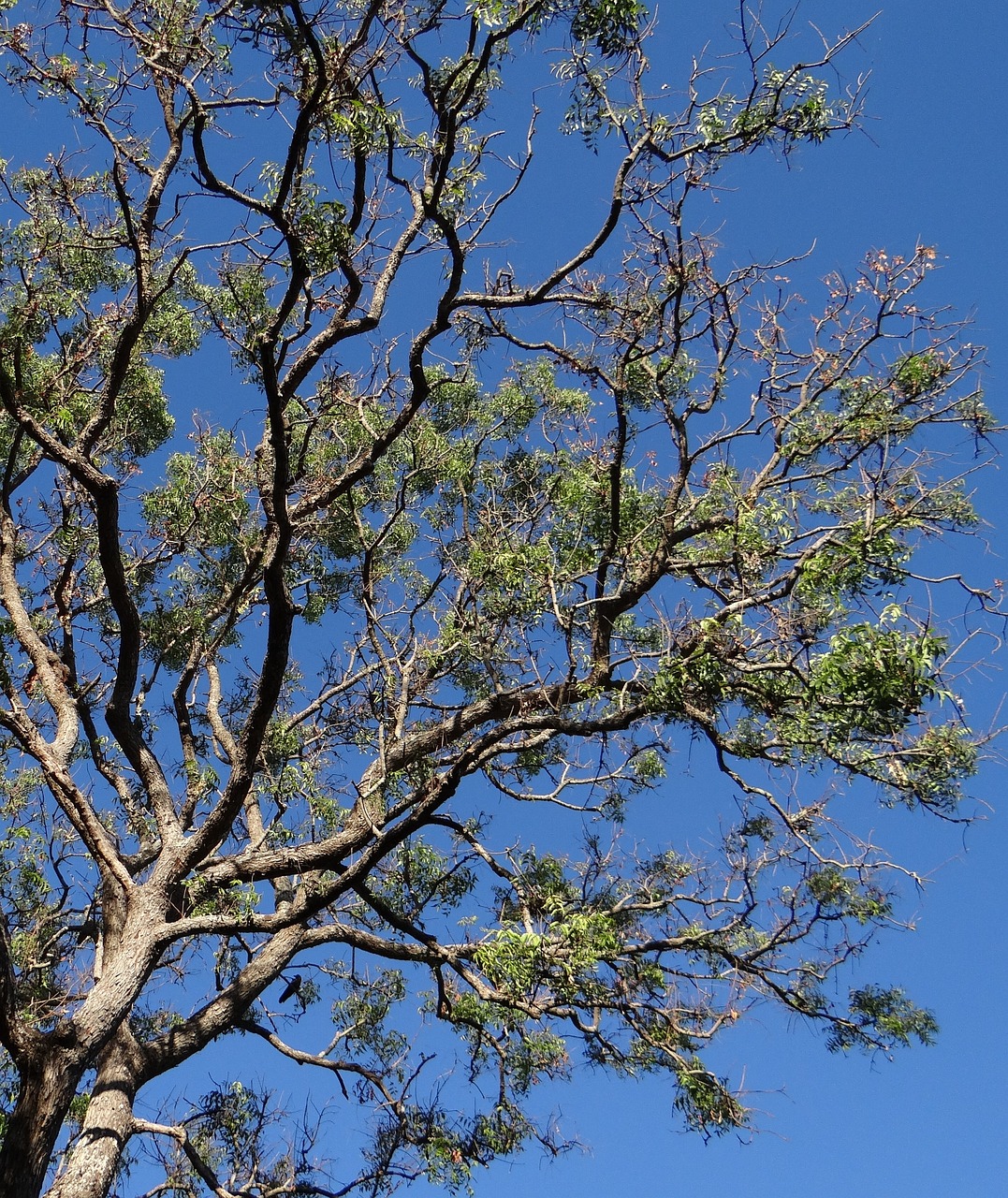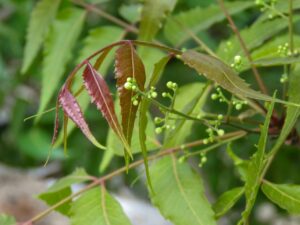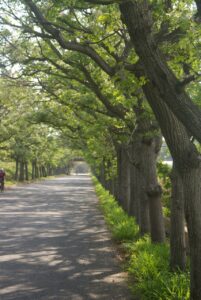Neem
Overview
Neem, scientifically known as Azadirachta indica, is a versatile evergreen tree native to India and Pakistan. Revered for its economic and medicinal value, Neem thrives in tropical climates and offers a trove of benefits, from pest control to health remedies, backed by a history of use spanning over 4,500 years1 4.

Characteristics
Known for its pest control properties, medicinal benefits, and resilience in varying growth conditions.
Region
The Neem plant is commonly found and grown in tropical regions, particularly in India and Pakistan.
Natural Habitat
Typically found in tropical and semi-tropical forests.
Cultivation
Thrives in full sunlight, prefers regular watering without overwatering, and grows best in well-drained soil.
Uses and Benefits
The Neem tree is a natural powerhouse that offers a wide range of benefits for both agriculture and health. Its oil is a gentle yet effective herbicide, making it an excellent choice for pest control without the need for harsh chemicals1. This makes Neem a valuable asset for gardeners and farmers looking to maintain healthy crops while minimizing environmental impact.
Beyond its agricultural uses, Neem is also a treasure trove of medicinal properties. The leaves of the Neem tree are rich in anti-viral compounds and glycosides, which can help support blood sugar regulation. This natural approach to health management has been recognized for centuries, with Neem playing a significant role in traditional medicine for over 4,500 years.
One of the most notable benefits of Neem is its ability to address various skin issues. Its time-honored use in traditional medicine underscores its effectiveness in promoting healthy, clear skin. Whether you’re dealing with minor blemishes or more persistent skin concerns, Neem offers a plant-based solution that has stood the test of time.
The versatility of Neem extends beyond its medicinal applications. Here are just a few of the many ways you can incorporate this incredible plant into your daily life:
- Create a natural pesticide spray for your garden using Neem oil
- Use Neem leaf extracts in your skincare routine for a natural glow
- Incorporate Neem supplements into your diet to support overall wellness
- Apply Neem oil to your scalp to promote healthy hair growth
Whether you’re a gardening enthusiast, a natural health advocate, or simply someone looking to embrace the power of plants, Neem is a valuable addition to your toolkit. Its long history of use and wide range of benefits make it a go-to choice for those seeking a natural approach to health and wellness.

Cultivation Tips
Cultivating Neem (Azadirachta indica) is a rewarding experience for gardeners who appreciate its love for the sun and hardy nature. To optimize growth, place your Neem tree in a location that receives full sunlight for the majority of the day. While regular watering is essential to maintain its lush foliage, be cautious not to overwater, as this can potentially damage the tree.
Neem tree propagation offers flexibility for a range of gardeners, as it can be done through various methods:
- Seeds
- Cuttings
- Root suckers2
When cultivating Neem, it’s crucial to be aware of seasonal changes and your regional climate suitability. Despite the tree’s resilience, checking these factors can make a significant difference in its growth and overall health.
One of the bonus features of having a Neem tree in your garden is its pest-resistant traits, which may benefit nearby plants. By reducing the need for chemical pesticides, Neem trees can contribute to a more harmonious garden ecosystem.5
As a final note, remember that moderation is key when it comes to caring for your Neem tree, especially in terms of watering. By finding the right balance, you’ll be able to enjoy the beauty and benefits of this versatile tree for years to come.
Seasonal Considerations
Neem trees (Azadirachta indica) are resilient plants that thrive in full sun, making them an excellent choice for gardens in suitable climates. When it comes to seasonal considerations, it’s essential to understand the plant’s natural growth cycle and how it responds to changes in temperature and rainfall.
In regions with distinct seasonal variations, Neem trees may experience a brief period of dormancy during the coldest months. However, they quickly bounce back with the arrival of warmer temperatures and increased sunlight. To support the tree’s growth throughout the seasons, consider the following:
- Water regularly during the growing season, but be mindful not to overwater as this can lead to root damage.
- Reduce watering frequency during the dormant period, allowing the soil to dry out slightly between watering sessions.
- Mulch around the base of the tree to help retain moisture and regulate soil temperature.
- Protect young Neem trees from frost damage by covering them with frost cloths during unusually cold spells.
Neem trees are known for their pest-resistant properties, which can benefit surrounding plants by reducing the need for chemical pesticides2. This trait makes them a valuable addition to any garden, promoting a healthier and more balanced ecosystem.
By paying attention to seasonal changes and providing appropriate care, you can ensure your Neem tree thrives year-round, offering its numerous benefits to your garden and home.

Issues and Troubleshooting
Growing a Neem tree requires striking the right balance of sunlight and water. Too much water can lead to root rot, while too little can cause the tree to struggle. To avoid these issues, monitor your Neem tree closely and adjust your care routine as needed. Here are some tips for troubleshooting common problems:
- Yellowing leaves: This can be a sign of overwatering or poor drainage. Make sure your Neem tree is planted in well-draining soil and only water when the top inch of soil feels dry.
- Wilting or drooping leaves: Underwatering or extreme heat can cause leaves to wilt. Check the soil moisture and provide water if needed. If the tree is in a hot, sunny spot, consider providing some afternoon shade.
- Slow growth: Neem trees are relatively slow-growing, but if your tree seems to be struggling, it may not be getting enough nutrients. Feed your tree with a balanced, organic fertilizer once a month during the growing season.
- Pest problems: While Neem trees are naturally pest-resistant, they can still be affected by certain insects like scale or mealybugs. If you notice any pests on your tree, treat it with a natural, neem oil-based pesticide.2
By keeping a close eye on your Neem tree and addressing any issues promptly, you can help ensure it thrives in your garden. As a bonus, the Neem tree’s pest-resistant properties may even help protect nearby plants from harmful insects.5
History and Folklore
The Neem tree, Azadirachta indica, has a rich history deeply rooted in ancient Indian culture and folklore. For centuries, this evergreen tree has been revered for its remarkable medicinal properties and has played a significant role in traditional healing practices. Neem’s importance extends beyond its practical applications, as it has become a symbol of nature’s inherent value in sustaining human life.
In ancient Indian texts, Neem is often referred to as “Sarva Roga Nivarini,” which translates to “the curer of all ailments”4. This designation highlights the deep respect and faith that communities had in Neem’s healing capabilities. The tree’s various parts, including its leaves, bark, and seeds, were used to create remedies for a wide range of health issues, from skin disorders to digestive problems.
Neem’s influence extends beyond medicine and into agriculture and pest control. Farmers have long relied on Neem-based products to protect their crops from insects and other pests, as the tree possesses natural insecticidal properties. This eco-friendly approach to pest management has been practiced for generations, showcasing the ingenuity of communities in leveraging nature’s gifts.
As modern science continues to validate the medicinal properties of Neem, its historical significance and cultural reverence remain undiminished. The tree’s storied past serves as a testament to the wisdom of ancient civilizations and their deep understanding of the natural world’s potential to support and heal.
References
1. “The Ultimate Guide to Neem Trees: Benefits, Uses, and Cultivation.” Kadiyam Nursery. https://kadiyamnursery.com/blogs/plant-guide/the-ultimate-guide-to-neem-trees-benefits-uses-and-cultivation
2. “Neem Tree Information: Learn How To Grow A Neem Tree – Gardening Know How.” Gardening Know How. https://www.gardeningknowhow.com/ornamental/trees/neem-tree/neem-tree-information.htm
3. “How to Grow the Neem Plant – Clean Air Gardening.” Clean Air Gardening. https://www.cleanairgardening.com/neem-plant/
4. “Neem Benefits for Skin & Health – Ayurvedic Herb Guides – Banyan Botanicals.” Banyan Botanicals. https://www.banyanbotanicals.com/info/plants/ayurvedic-herbs/neem/
5. “Neem | Description & Uses | Britannica.” Britannica. https://www.britannica.com/plant/neem-tree
Nicolas Duval
Nicolas is a passionate advocate for nature and the art of wildcrafting. His dedication shines through in Wildcraftia, a website he meticulously crafted to serve as a haven for nature enthusiasts worldwide. Driven by a deep appreciation for nature’s connection to humanity, Nicolas embarked on his journey in 2011 with SmokableHerbs, a platform showcasing his love for nature’s bounty. Building upon this foundation, he established Smokably, a thriving online store offering premium herbs and blends to a global audience.
